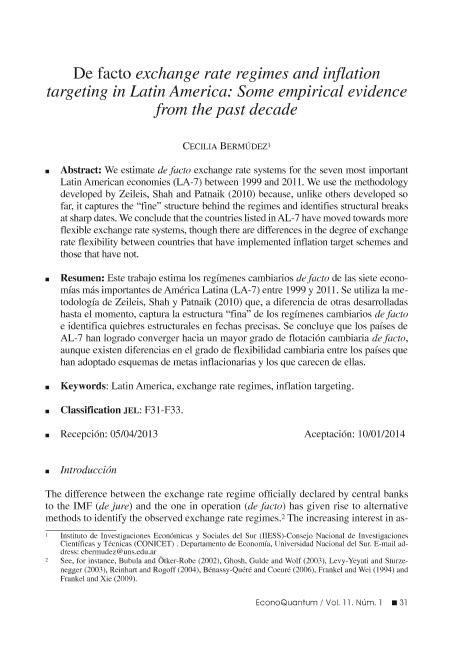Artículo
Este trabajo estima los regímenes cambiarios de facto de las siete economías más importantes de América Latina (LA-7) entre 1999 y 2011. Se utiliza la metodología de Zeileis, Shah y Patnaik (2010) que, a diferencia de otras desarrolladas hasta el momento, captura la estructura "fina" de los regímenes cambiarios de facto e identifica quiebres estructurales en fechas precisas. Se concluye que los países de AL-7 han logrado converger hacia un mayor grado de flotación cambiaria de facto, aunque existen diferencias en el grado de flexibilidad cambiaria entre los países que han adoptado esquemas de metas inflacionarias y los que carecen de ellas. We estimate de facto exchange rate systems for the seven most important Latin American economies (LA-7) between 1999 and 2011. We use the methodology developed by Zeileis, Shah and Patnaik (2010) because, unlike others developed so far, it captures the "fine" structure behind the regimes and identifies structural breaks at sharp dates. We conclude that the countries listed in AL-7 have moved towards more flexible exchange rate systems, though there are differences in the degree of exchange rate flexibility between countries that have implemented inflation target schemes and those that have not.
De facto exchange rate regimes and inflation targeting in Latin America: some empirical evidence from the past decade
Fecha de publicación:
06/2014
Editorial:
Universidad de Guadalajara
Revista:
EconoQuantum
ISSN:
1870-6622
Idioma:
Inglés
Tipo de recurso:
Artículo publicado
Clasificación temática:
Resumen
Palabras clave:
Latin America
,
Exchange Rate Regimes
,
Inflation Targeting
Archivos asociados
Licencia
Identificadores
Colecciones
Articulos(IIESS)
Articulos de INST. DE INVESTIGACIONES ECONOMICAS Y SOCIALES DEL SUR
Articulos de INST. DE INVESTIGACIONES ECONOMICAS Y SOCIALES DEL SUR
Citación
Bermúdez, Cecilia; De facto exchange rate regimes and inflation targeting in Latin America: some empirical evidence from the past decade; Universidad de Guadalajara; EconoQuantum; 11; 1; 6-2014; 31-57
Compartir




